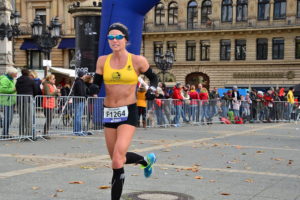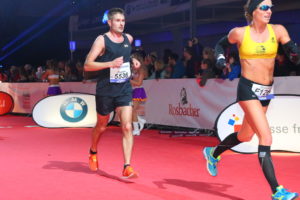 Last week I posted about the importance of the off season. Today I want to personally share how I handled my off season, and what lessons I learned about myself as an athlete in my latest marathon cycle, and how I’ll plan to make changes in the future. It’s important to understand that our bodies will adapt and change to anything we toss at it – with time, consistency, and a solid combination of work and recovery. It’s always easier to be the coach than the athlete, and I’ve worn both hats for myself for the last few years. While I know my body and my strengths and weaknesses, it’s not without its challenges.
Last week I posted about the importance of the off season. Today I want to personally share how I handled my off season, and what lessons I learned about myself as an athlete in my latest marathon cycle, and how I’ll plan to make changes in the future. It’s important to understand that our bodies will adapt and change to anything we toss at it – with time, consistency, and a solid combination of work and recovery. It’s always easier to be the coach than the athlete, and I’ve worn both hats for myself for the last few years. While I know my body and my strengths and weaknesses, it’s not without its challenges.
Frankfurt Marathon Training: In Spring I dealt with my first injury in 5 years. I have a heel spur in my left foot that became irritated, and plantar fasciitis stemmed from that heel. They were essentially one big issue. While I ordered special orthotics, put my foot through electrotherapy (not pleasant nor cheap!), and did everything I could, I was also asked to stop running at full body weight. So with Frankfurt, my goal marathon, waiting in the wings on October 29th, I knew the clock was ticking. I ran the entire month of June at 50-80% of my body weight on the Alter-G at Finish Line PT. The monthly membership there was beyond worth it. I was able to run – which I needed physically and mentally. In July, 15 weeks from marathon day, I was given the green light to run outside. I had 15 weeks to go from base mileage on an Alter-G, to chasing down a PR. There were times my foot still hurt leading up to Frankfurt, but at least I knew how to manage it. With a pretty short window of time, I decided to be conservative with mileage. My highest mileage week was maybe 45 miles. My longest run, 20-milers. I supplemented my training with 5-7 hours of weight training per week.
Frankfurt Marathon Reflections: Moving forward, I’d ideally have had a few more weeks of official training, and some time to build solid base mileage outside. That’s my hope for my fall 2018 goal. Also, if I’m honest about my weaknesses, I fell apart late on the course. The weather was tough, and that made me lose my head game. However, my body was capable of more than I accomplished out there – even in those conditions. Therefore, some longer long runs (21-23-milers), and some more negative-split/progressive long runs are what I’ll need to develop a stronger mental space for those late miles. I’ll also plan to increase weekly mileage a bit for next fall. I know I’m not a high mileage athlete, but I think I can add a bit more and still feel healthy and strong.
The Off Season: I’m incredibly disciplined as an athlete. Despite the fun foods I post on IG (and don’t get me wrong – I love all foods!), I also track everything I consume – the good, the bad – I track it all. I’m also disciplined with my training. I can eat a lot because most of the time I burn a lot. I’m training 2 hours per day, on average. That buys me a lot of extra calories. But during the last 4 weeks, I’ve allowed myself to relax. In fact, while in Mexico for a week’s vacation, I didn’t track a single calorie or activity. For the first time in a VERY long time, I gave myself a guilt-free, no rules, do what you want, vacation. I ordered guacamole with everything. I inhaled corn chips like it was my job. I ordered margaritas and buckets of beer without hesitation. It. Was. Fabulous. The month of November had minimal training (some lifting in the gym and minimal mileage), and I tried to really relax, reflect on my training, my accomplishments and my weaknesses, and how to better train and race in 2018.
Moving Forward: So after a training cycle that, despite the bumps along the way, still lead to a marathon PR, I have reflected, rested, and am ready to get back to work. I have no idea how much weight I’ve gained in the last 4 weeks. I refuse to weigh myself right now. I should be focused purely on the training and adapting. Race weight isn’t the focus at this time. But my mind is ready, and my body feels recovered from the marathon – and that’s what’s most important.
My goal race for early 2018 is the Saint and Sinners Half, in Nevada. I ran it last year, set a 6+ minute PR, and won. This year I am going back and hoping to break 1:20. That’s a blazing 6:05 minute mile average. I could NEVER do that on the average half marathon course. But this one is 1200 ft. net downhill, and I run downhill really well. You better believe I’ll be getting my quads and calves ready. I’ll then run Boston Marathon. No goals in time for that right now. I will simply see where my fitness is after the half. I may offer to pace a friend or team mate. I’m not putting any pressure on Boston. Last year I neglected the recovery necessary after the half, and I think that’s what began to cause my foot issues. I won’t make that mistake again. After Boston, I’ll plan for a little off season, and then gear up for a fall 2018 marathon. Right now I’m seriously considering Saint George Marathon. It’s known for its 2000+ net downhill, and being a beautiful course. Again, downhill races aren’t without their challenges. But I know how to train for that and I think that would be a great course for breaking 3 hours. But for now, my eye is on the Half in February. I have 12 weeks.
Advice for You: Above you can see how I’ve handled and structured my goals. As you look towards 2018, space out your goal races in a realistic manner. We cannot do everything. Give your body TIME. Rushing into something, especially a marathon, can be quite risky. Assess your strengths and weaknesses. What should you focus on this year? Put together an organized plan, hire a coach, or find a running club. A clear plan will reduce injury risk and help with motivation and consistency. Lastly, take and embrace the off season. You will come back better.
 The off season. Most runners are really bad at this. It’s incredibly tempting to cross that goal finish line fired up and ready to dive into the next goal. Even if legs feel great within a day or two of that goal race, it’s important to relax and PAUSE. I completely understand that post-marathon high. I clearly remember days after my first marathon, signing up for two spring marathons with all the enthusiasm in the world. We feel invincible, fired up and inspired. PAUSE. Injury risk is incredibly high within the days/weeks following that goal marathon. Even if you FEEL good, trust that there are things that are broken down and rebuilding. Remember that just like the hard work and the taper, a reverse taper is necessary. The best marathoners in the world take an off season. None of us are the exception. How long or dramatic of an off season an athlete needs will vary. But when in doubt, be conservative.
The off season. Most runners are really bad at this. It’s incredibly tempting to cross that goal finish line fired up and ready to dive into the next goal. Even if legs feel great within a day or two of that goal race, it’s important to relax and PAUSE. I completely understand that post-marathon high. I clearly remember days after my first marathon, signing up for two spring marathons with all the enthusiasm in the world. We feel invincible, fired up and inspired. PAUSE. Injury risk is incredibly high within the days/weeks following that goal marathon. Even if you FEEL good, trust that there are things that are broken down and rebuilding. Remember that just like the hard work and the taper, a reverse taper is necessary. The best marathoners in the world take an off season. None of us are the exception. How long or dramatic of an off season an athlete needs will vary. But when in doubt, be conservative. First and foremost, I apologize for neglecting my blog for much of 2017. That’s about to change! Second, it has been an incredible year. I am so humbled and proud of the hard work my roster have brought to the table. It’s an honor to do what I do every day.
First and foremost, I apologize for neglecting my blog for much of 2017. That’s about to change! Second, it has been an incredible year. I am so humbled and proud of the hard work my roster have brought to the table. It’s an honor to do what I do every day. I would absolutely recommend Frankfurt Marathon to anyone looking for a flat and fast marathon. It was a pretty amazing day. And the days following the marathon were really fun. Food and drink is everywhere. If you enjoy baked goods and beer, Germany is for you. Frankfurt is an incredibly friendly city to travelers from all over the globe.
I would absolutely recommend Frankfurt Marathon to anyone looking for a flat and fast marathon. It was a pretty amazing day. And the days following the marathon were really fun. Food and drink is everywhere. If you enjoy baked goods and beer, Germany is for you. Frankfurt is an incredibly friendly city to travelers from all over the globe.


